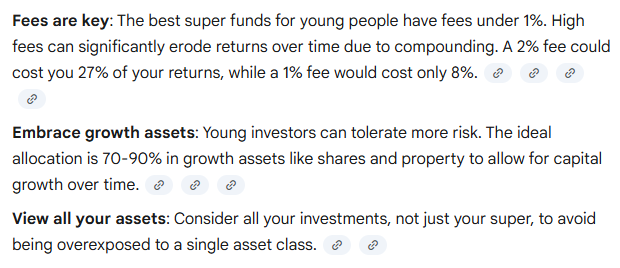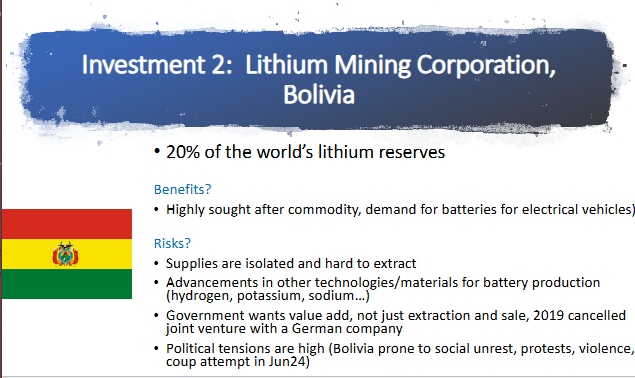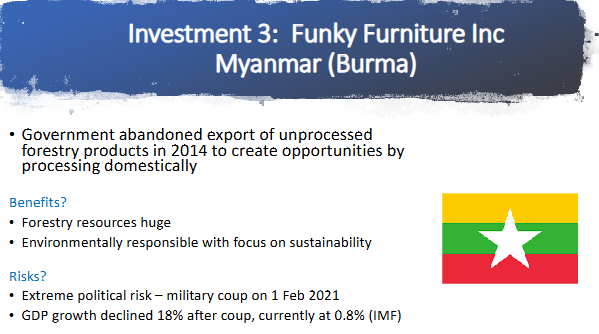Applied Financial Decision Making
1/28
There's no tags or description
Looks like no tags are added yet.
Name | Mastery | Learn | Test | Matching | Spaced |
|---|
No study sessions yet.
29 Terms
When was compulsory superannuation introduced in Australia?
1992
What was the initial super contribution rate?
3%
What is the Sharpe Ratio?
(Average return - risk free rate)/Standard deviation on returns
What are some things that Millennials and Gen Z need to watch in their super?

How are young workers missing out on higher super returns?

Did negative interest rates work?
The era of negative interest rates in Europe is ending as countries like Switzerland, Sweden, and Denmark raise their rates due to surging inflation, leaving Japan as the last major economy with the policy. Central bankers claim the policy was a success, estimating it led to an average of
0.7% extra bank lending per year. Critics argue the policy damaged lenders and inflated asset bubbles, with savers in Germany particularly frustrated by being charged to hold deposits. German banks returned a record €11 billion in cash after the ECB's deposit rate rose to zero, suggesting the policy caused some hoarding of hard currency.
What are emerging and frontier economies?
Countries beginning to move away from traditional agricultural and raw material exporting
What is an emerging economy?
Countries in the process of becoming a developed economy. Becoming more expensive as a base of operations. E.g. India, Mexico
What is a frontier economy?
Less advanced economies, less advanced than emerging markets that possess one or more of the following characteristics:
Politically manipulated markets
Weak legal system
Low per capita income or faltering GDP
E.g. Myanmar, Vietnam, Rwanda
What are the benefits of investing in an emerging or frontier economy?
Very high growth potential, fast growing population, international investors may not be there yet
Low correlation with rest of world/benefit to diversification
Cheap/low valuations
What are the risks to investing in an emerging or frontier economy?
Highly volatile
Expropriation or political risk
illiquid
lack of transparency
large currency fluctuations
inadequate regulation
What are some other considerations to investing in an emerging or frontier economy?
Ethics, sustainability, long-term commitment
What happened in the 1980’s in regards to aluminium manufacturing in Venezuela?
Cheap power made it possible to manufacture aluminium at very low costs
Venezuela was willing to undertake joint ventures with foreign companies to build the smelters
Many foreign investments have been expropriated with investors losing everything
What is a fact about banking in Vietnam?
A major percentage of the country is still not in the banking system
How much of the worlds’ lithium reserves does Bolivia own?
20% of the worlds lithium reserves
What are some benefits and risks for investing in Vietnam?

What are some benefits and risks for investing in Bolivia?

What are some benefits and risks to investing in Myanmar?

What is underwriting income?
Total premiums collected - claims paid - expenses
What is invest income?
Investing the premium that insurance companies receive
What are some risks for an insurance company?
Ethical issues when propagating ethnic profiling
Risk of perception of discrimination
Fail to include or fail to raise premiums could lose money
What are negative interest rates?
Cash deposits at banks may incur a charge for money to be safely held in the bank
Typically during a deflationary period
Usually negative at a central bank, designed to encourage banks to lend money more easily so the money is not held at the bank
Lack of transparency
What is the effect on the average person of negative interest rates?
Lower cost of borrowing
No return for investors (zero returns)
Decline in value of real savings
Asset prices could rise due to cheap borrowing
What is the effect on the economy of negative interest rates?
Currency will depreciate (exports cheap, imports expensive)
Stimulate the economy
Investment desirable
Creates instability in the banking industry
What does immunisation mean?
Risk mitigation strategy that matches assets and liability duration portfolios against interest rates changes
What is duration?
Duration is a way of measuring the interest rate risk of an individual or portfolio of fixed income securities
How can negative interest rates affect immunisation of cash flows for an insurance company?
Factor into pricing, no effect if properly immunised
Why do the assets backing the liabilities of an insurance company have a shorter duration than the liabilities?
Because longer duration fixed income assets are not available OR
Because they do not want to invest in long low yielding bonds and lock in losses
Traditional guaranteed products with long durations have been difficult to immunise with available fixed income assets
How can we increase the return on assets when there are negative interest rates?
Add credit spread/decrease quality of assets/take on more illiquidity risk
Increase more risky assets
Increase YTM of debt assets by combinations of sales/purchases